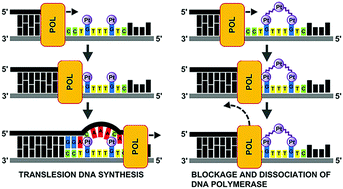Translesion DNA synthesis across double-base lesions derived from cross-links of an antitumor trinuclear platinum compound: primer extension, conformational and thermodynamic studies†
Abstract
Polynuclear platinum complexes represent a unique structural class of DNA-binding agents of biological significance. They contain at least two platinum coordinating units bridged by a linker, which means that the formation of double-base lesions (cross-links) in DNA is possible. Here, we show that the lead compound, bifunctional [{trans-PtCl(NH3)2}2μ-trans-Pt(NH3)2{H2N(CH2)6NH2}2]4+ (Triplatin or BBR3464), forms in DNA specific double-base lesions which affect the biophysical and biochemical properties of DNA in a way fundamentally different compared to the analogous double-base lesions formed by two adducts of monofunctional chlorodiethylenetriamineplatinum(II) chloride (dienPt). We find concomitantly that translesion DNA synthesis by the model A-family polymerase, the exonuclease deficient Klenow fragment, across the double-base lesions derived from the intrastrand CLs of Triplatin was markedly less extensive than that across the two analogous monofunctional adducts of dienPt. Collectively, these data provide convincing support for the hypothesis that the central noncovalent tetraamine platinum linker of Triplatin, capable of hydrogen-bonding and electrostatic interactions with DNA and bridging the two platinum adducts, represents an important factor responsible for the markedly lowered tolerance of DNA double-base adducts of Triplatin by DNA polymerases.



 Please wait while we load your content...
Please wait while we load your content...